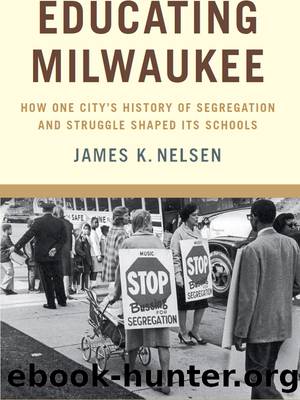Educating Milwaukee by Nelsen James K.;

Author:Nelsen, James K.;
Language: eng
Format: epub
ISBN: 978-0-87020-721-1
Publisher: Wisconsin Historical Society
Published: 2016-01-22T00:00:00+00:00
SMALL HIGH SCHOOLS
MPS pursued one last major reform strategy involving choice in the 2000sâthe small high schools initiative. The movement began in the late 1980s in urban districts that were looking for innovative ideas to meet the needs of students who were not successful in traditional comprehensive high schools. Small high schools typically have fewer than four hundred students, and some have fewer than two hundred. A school may be in a stand-alone building, such as a former elementary school or a rented space, or it may be in a multiplexâa building that used to house a comprehensive high school but is reconfigured to accommodate three to six small high schools. Each school is supposed to have a particular theme, much like magnet schools, and the idea is that students will pick the schools for which they are best suited. Small schools are intended to foster a bond among students and between students and teachers. Classes may rotate from one teacher to another, as in a middle school. Because the enrollment is so small, students may have the same teachers for all four years of high school. Sports, clubs, and electives are harder to offer, however,131 because small schools cannot take advantage of economies of scale.132 The public took little notice in the small schools movement until 2003, when the Bill and Melinda Gates Foundation donated $51 million to New York City to start sixty-seven small high schools. The foundation gave millions more in subsequent years to other districts, including Milwaukee, to establish small high schools.133
After studying small high school designs in Baltimore and New York, MPS planned to create forty-five schools between 2003 and 2008 that would serve about sixteen thousand students, despite inconclusive research on the effectiveness of small high schools.134 Originally, the district planned to convert seven of the fifteen high schools to multiplexes, effectively abolishing a large portion of the magnet school plan. The Gates Foundation committed more than $17 million to the effort, intended to help MPS modify buildings and retrain staff.135
But the district converted only three high schools to small school multiplexes. North Division, once the medical and dental science magnet, was broken up into three schools in 2003: the School of the Humanities, the Truth Institute for Leadership and Service, and the Genesis School of Business Technology/Trade, Health, and Human Services. At the time, about half of North Divisionâs entering freshmen read below a fourth-grade level, and the schoolâs attendance level was only about two-thirds of students. District officials hoped the small schools would foster a sense of belonging and that achievement would improve.136 Washington (the computer magnet) and Marshall (the broadcasting magnet) were broken up in 2004. South Division (tourism, food service, and recreation) and Bradley Tech were allowed to remain comprehensive schools but were reconfigured internally to create âsmall learning communitiesâ in the schools, similar to the schools in a multiplex but with one administrative structure.137
Although most district officials praised the moves, there were a few dissenters. Tom Balistreri, a school
Download
This site does not store any files on its server. We only index and link to content provided by other sites. Please contact the content providers to delete copyright contents if any and email us, we'll remove relevant links or contents immediately.
Chicken Soup for the Soul Presents Teens Talkin' Faith by Jack Canfield(689)
Understanding PDA Autism in Kids: A Guide for Parents and Teachers to Support Neurodiverse Learners by Jehu Len(558)
The Victorian Era: A Captivating Guide to the Life of Queen Victoria and an Era in the History of the United Kingdom Known for Its Hierarchy-Based Social Order by Captivating History(428)
Brain Teasers to Build Critical Thinking Skills: Brain Exercises for Tech, Banking, Case Interview Prep, and to Keep Your Mind Sharp by Kris Safarova(415)
Brain Teasers to Build Critical Thinking Skills by Safarova Kris(412)
100 Ideas for Secondary Teachers: Engaging Parents by Janet Goodall & Kathryn Weston(391)
Python 101 - Fundamentals by Sam(375)
Critical Curriculum Leadership : A Framework for Progressive Education by Rose M. Ylimaki(365)
Writing Solid Code: Development Philosophies for Writing Bug-Free Programs by Steve Maguire(360)
The Art of Emotional Validation: Improve Your Communication Skills and Transform Your Relationships by Validating Emotions and Feelings by Emily Wright(340)
Intersectionality in Educational Research by Dannielle Joy Davis; James L. Olive; Rachelle J. Brunn-Bevel; Susan R. Jones(336)
The Knights Templar: An Enthralling History of the Rise and Fall of the Most Influential Catholic Military Order by Wellman Billy(330)
A Beginner's Guide to SSD Firmware by Unknown(329)
The Future Knowledge Compendium by Ellyard Peter;(320)
How to be assertive in any situation by Hadfield Sue & Hasson Gill(312)
Foundations of Educational Research by Victoria Elliott(308)
What Every Teacher Should Know about Learning, Memory, and the Brain by Tileston Donna E. Walker;(307)
Making Connections in and Through Arts-Based Educational Research by Hala Mreiwed Mindy R. Carter Sara Hashem Candace H. Blake-Amarante(306)
Message from the Pleiades; The Contact Notes of Eduard Billy Meier v1 only by unknow(302)
